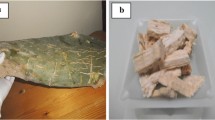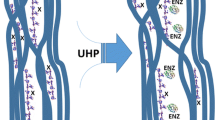Abstract
Very high yield sulphite pulps were produced by cooking black spruce wafers in pulping liquors at pH 7 or 10, containing 0.1% (on O.D. wood) of soluble anthraquinone (SAQ). These pulps had better strength properties relative to controls prepared without SAQ, breaking length and burst index being greater, on average, by 20%. Other improvements included: increased pulping rate, lower lignin contents at comparable pulp yields, and higher carbohydrate content at the same level of residual lignin in pulp (this resulted in an increase of total pulp yield by 2%). Results of cooks in liquors ranging in pH from 4 to 10, and under variable conditions of time (20–60 min) and temperature (120–160°C) suggested that: firstly, AQ does not act as a pulping catalyst at pH 4, and secondly, the sulphonate contents of AQ-catalyzed pulps are lower than those of the uncatalyzed controls. In the light of the lower sulphonate content, the higher strength is unexpected.
Similar content being viewed by others
Cited References
Y. Nomura and M. Nakamura,Japan Tappi 33, 174 (1979).
D.W. Cameron, B. Jessup, P.F. Nelson, W.D. Raverty, E. Samuel, and N. Vanderhoek,The Response of Pines and Eucalyptus to NSSC-AQ Pulping, Ekman Days Symp.II: 64 (1981) Stockholm.
B.I. Fleming, M.C. Barbe, K. Miles, D.H. Page, and R.S. Seth,J. Pulp Paper Sci. 10, 113 (1984).
O.V. Ingruber, M. Stradal, and J.A. Histed,Pulp & Paper Can 83, 79 (1982).
P. Tikka and J. Tulppala,Neutral Sulphite AQ Pulping and Bleaching of the Pulps, Int. Sulphite Pulping Conference, Proceedings p. 11, (1982).
N.-E. Virkola, R. Pusa, and J. Kettunen,Tappi J 64, 103 (1981).
C.H. Tay, R.S. Fairchild, and D.F. Manchester,J. Pulp Paper Sci. 10, 134 (1984).
C.H. Tay, R.S. Fairchild, and S.E. Imada,Tappi J. 68, 98 (1985).
C.H. Tay and. Imada,J. Pulp Paper Sci. 12, 60 (1986).
S.E. Imada, R.S. Fairchild, and C.H. Tay,J. Pulp Paper Sci. 13, J39 (1987).
B.I. Fleming, G.J. Kubes, J.M. MacLeod, and H.I. Bolker,Tappi J. 61, 43 1978.
A. Keskin and G.J. Kubes,J. Pulp Paper Sci. 16, J163 (1990).
A. Keskin and G.J. Kubes,J. Pulp Paper Sci. 20, J45 (1994).
A. Keskin and G.J. Kubes,J. Wood Chem. Technol. 14, 103 (1994).
A. Keskin and G.J. Kubes,The Role of Anthraquinone in Neutral Sulphite-Anthraquinone Pulping, AIChE 1991 Forest Products Symposium Proceedings, pp. 33–43, Tappi Press, Technology Park/Atlanta, (1992).
G.J. Kubes, B.I. Fleming, J.M. MacLeod, and H.I. Bolker,J. Wood Sci. Technol. 14, 207 (1980).
W. Schöniger,Mikrochemica Acta 1, 1223 (1955).
G.-O. Franklin and A.W. Fitchett,Pulp & Paper Can. 83, T271 (1982).
C. Heitner, R.P. Beatson, and D. Atack,J. Wood Chem. Technol. 2, 169 (1982).
Author information
Authors and Affiliations
Rights and permissions
About this article
Cite this article
Kubes, G.J., Wang, B. & Keskin-Schneider, A. Catalyzed sulphite and semichemical pulping. Res. Chem. Intermed. 21, 489–501 (1995). https://doi.org/10.1007/BF03052272
Received:
Accepted:
Issue Date:
DOI: https://doi.org/10.1007/BF03052272




